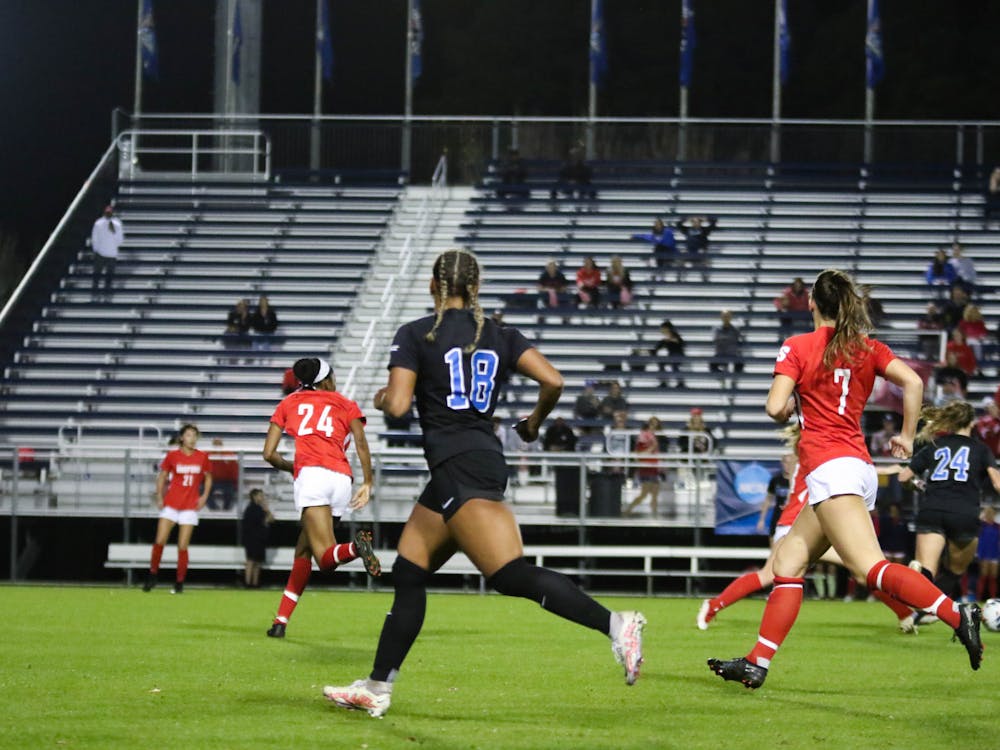One of the main priorities of defenses taking on the Blue Devils should be to shut down “two of the best forwards in the United States,” as Radford head coach Ben Sohrabi described Duke forwards freshman Kat Rader and sophomore Michelle Cooper.
In their first-round NCAA tournament contest against the No. 2-seed Duke, the Highlanders tried to do that, albeit with a more unconventional approach.
Radford man-marked the Blue Devils' front five players, which includes the three forwards and two wingbacks, for the entire 90 minutes of Duke's 4-0 victory Saturday evening. Man-marking is a tactic in which defenders are tasked with covering a specific player instead of an area of the field, traditionally used to limit opportunities for one or two key players from the opposing team, like a strong striker.
“They marked us man-to-man all over the field, and it took us a little bit—some adjustments, changing some runs, some ways that we played entry ball in and some angles that we played entry balls in,” head coach Robbie Church said after the game. “… And as the game went on, we just kept pushing them back and back.”
Radford’s Helena Willson and Jillian Silverstone led the bracket coverage of Cooper, where whoever was closer to the ball would act as a center back, while the other man-marked Cooper. Kennedy Dunnings stayed on top of Rader throughout the evening, while in a battle of the jersey No. 24s, Saleena Lynch kept an eye on graduate midfielder Mackenzie Pluck. Freshman wingback Elle Piper and graduate midfielder Delaney Graham also faced pressure from the Highlanders.
Man-marking itself isn’t a common setup in soccer, and involving all front five in the setup is even more unusual, forcing Duke to figure out how to combat the strategy on the fly.
“Man-marking is something we’ve never faced before, and it gave us a lot of room for creativity,” Cooper said. “We were able to try new things and learn new interchanges.”
“I mean, you don’t see a lot of man-to-man marking anymore,” Church added. “So we were trying to figure out, ‘Oh my gosh, what is this?’ … But I thought it was a good tactic for them for a while."
One of the primary adjustments the Blue Devils had to make was creating space for other unmarked players to come in and find opportunities. Instead of remaining at the top of Duke’s offense, Cooper eventually pulled back and positioned herself to the right of senior midfielder Sophie Jones. This dragged out Radford’s center backs, leaving open territory at the top for Duke’s wingers to make runs into that space and find opportunities from diagonal balls.
The adjustment allowed for Piper to finish Duke’s third goal of the evening, making her the 10th Blue Devil to notch their first collegiate goal during the NCAA tournament. Junior defender Katie Groff slid a pass to Piper near the sideline, who beat her two defenders and sent in a shot from inside the penalty box. Cooper, who was sitting back, had drawn Silverstone away from the play, and with the Highlanders’ other defenders occupied by watching Rader and Pluck waiting near the top of, there was no one to challenge Piper after she beat her defenders or get a foot on the shot, the ball eventually bouncing under the goalie and putting Duke up 3-0.
“I think [adjusting to the man-marking] was really difficult,” Cooper said. “Trying to create space for other people—that’s something we talked about in the locker room, that it's not really a movement for yourself, it's a movement to create space for other people because having someone on your tail the whole time is really difficult. It was just knowing that this is not for you, being selfless, and just making sure that we're doing it for each other to put it in the back of the net.”
The tactic, Sohrabi explained, is one the team utilized throughout Big South conference play. With the selection show having only taken place Monday, the team had little time to try to adjust their approach before Saturday evening’s contest in Durham.
“I think if we had a month to prepare for them, then we would do things differently,” he said after the game. “… You get three or four days to prepare for these guys. We tried a little bit, and they all came to me, like, it's tough on them. What works in our conference is that we go toe to toe with a lot of these teams, and I challenge our kids to compete on a 1-v.-1 level in a lot of ways—and you don't want to come here and change a whole bunch of different things because then it ends up 8-0 instead of 4-0.”
In Duke’s upcoming second-round matchup against No. 7-seed Texas Friday evening, they most likely won’t see a similar five-man marking strategy. But the Blue Devils have proven that they can make the on-the-fly adjustments to prepare for whatever the Longhorns will throw their way.
Get The Chronicle straight to your inbox
Signup for our weekly newsletter. Cancel at any time.

Leah Boyd is a Pratt senior and a social chair of The Chronicle's 118th volume. She was previously editor-in-chief for Volume 117.

